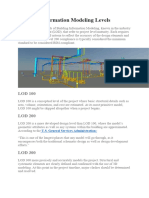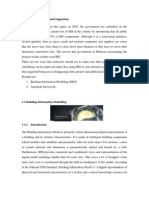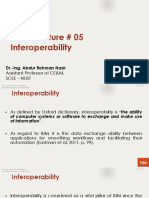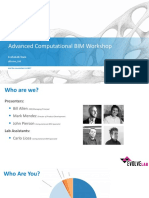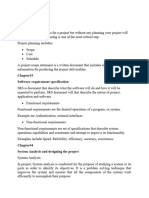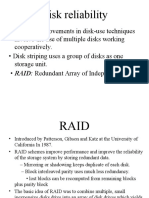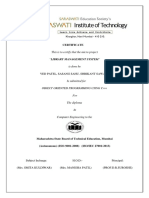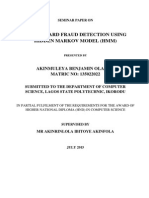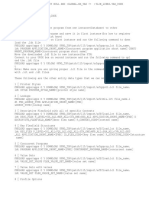Summary of Data Science
Uploaded by
AliifahSummary of Data Science
Uploaded by
AliifahAbout Data Science
Data Science : Unlocking Insights from data
Data science is the practice of mining large data sets of raw data, both structured and unstructured, to
identify patterns and extract actionable insight from them. Data Science enables businesses to process
huge amount of structured and unstructured big data to detect pattern. This is turn allows companies to
increase efficiencies, manage cost, identify new market opportunities, and boost their market advantage.
In short Data science is an interdisciplinary field that involves extracting valuable insights from vast
amounts of data. By combining statistical methods, programming, and domain knowledge, data
scientists can uncover hidden patterns, trends, and correlation within complex datasets. This Process
encompasses various stages, including data collection, cleaning exploration, modelling, and
visualization.
The Data Science Workflow : From Capture to Communication
1. Business understanding (define objectives for the problem that needs to be tackled) Imagine
data science as a multi-stage journey. The first step involves data capture, Which entails
acquiring data, sometimes extracting it from various sources, and bringing in into a usable
format for analysis.
2. The next stage focuses on data maintenance, encompassing warehousing, cleansing to address
inconsistencies, processing to transform the data, staging to prepare it for futher analysis, and
building the architecture that will support this processes
• Data Mining (Gather and scrape the data necessary for the project)
• Data Cleaning (fix the inconsistencies within the data and handle the missing values)
3. The heart of data science lies in data processing. This stage separates data scientist from data
engineers. It involves the exploration and mining of data, classification and clustering of data
points into meaningful groups, the creation of models to represent the data and summarizing
the insights from it.
4. Data exploration (From hypotheses about your defined problem by visually analyzing the data)
5. Following processing comes data Analysis. Here, data scientists employ a robust toolkit of
techniques like exploratory and confirmatory analysis to comfirm hypotheses, regression
analysis to identify relationships between variables, predictives analysis to forecast future
trends, this stage emphasizes the impotance approach to the specific data.
6. Feature Engineering (Select Important features and construct more meaningful ones using the
raw data that you have)
7. Predictive modelling (train machine learning models, evaluate their performance, and use them
to make predictions
8. Data Visualization (communicate the findings with the key stakeholders using plots and
interactive visualizations.) The final Stage involves communicating insights, Data scienctists
leverage data visualization techniques to present their findings in a clear and compelling
manner. They create reports utilizing various business intelligence tools to ensure stakeholders
understand the information.
The significance of data preparation and analysis
Although every stage is important, data preparation and exploration are particularly the most time-
intensive tasks for a data scientist. Typically, 60 to 70% of their time is spent on making sure the data
is clean, functional, and prepared for analysis. They evaluate whether the different characteristics in the
data set are independent and pinpoint any possible missing values. This phase of exploration is a
fundamental distinction between data science and data analysis. Data science adopts a comprehensive
perspective, focusing on identifying the most impactful questions to pose to the data, which in turn
maximizes the knowledge and insights gained.
Building Models with Data Science
After the data has been prepared and analyzed, data scientists apply machine learning algorithms to
develop models that can learn from the data and generate predictions. The selection of a model is
influenced by the kind of data and the particular requirements of the business. According to the test
results, the model can be further refined to enhance its performance. Once a model consistently produces
valuable insights, it is completed and put into operation.
Data Science in Practice Data science is transforming industries around the world.
In the healthcare sector, it is utilized to examine patient information in order to enhance diagnostic and
treatment strategies. In finance, it aids in identifying fraud, evaluating risk, and enhancing investment
strategies. Marketing teams utilize data science to analyze customer behavior, tailor campaigns, and
boost sales. In the end, data science empowers organizations to make decisions based on data, enhance
their efficiency, and secure a competitive edge. As data volumes keep increasing, the significance of
data science will also rise, making it a crucial skill for any business or organization aiming to succeed
in the digital era As data volumes continue to grow, so too will the importance of data science, making
this competency a key one for any business or organization that wants to thrive in the digital age.
Data science vs Data Analysis
Data Scientists and data analysis are often confused, but they have distinct roles.
1. Data Scientists focus on exploring large, often unstructured datasets to discover patterns and
trends. They build predictive models and often work on the forefront of data innovation.
2. Data Analysis typically work with structured data to answer specific business questions. They
use existing data to provide insights and recommendations.
While both roles require analytical skills, data scientists have a border skill set, including machine
learning and advanced statistical modelling. Data analysts tend to have stronger focus on business
acumen and communication skills.
Big Data and Data Science
Big data refers to massive datasets that are complex. Diverse, and rapidly growing. It encompasses
structured data (e.g., databases), semi-structured data (e.g., XML files), and unstructured data (e.g., text,
images, videos).
Data Science is the discipline of extracting valuable insights from these large datasets. It involves a
combination of statistical methods, programming, and domain knowledge. Data scientists prepare and
process big data, transforming it into a usable format for analysis.
While often confused, data scientists focus on analysis and insight generation, while data engineers
handle the technical aspects of data preparation and management. Together, they form a crucial team
for harnessing the power of big data.
Data Science and statistics are closely related but distinct fields
Data Sience is a broad discipline encompassing various fields like statistics, computer science, and
business. It focuses on extracting insights from large, often complex data sets. Statistics provide the
foundation for data analysis, offering methods for data collection, analysis, and interpretation.
Essentially, statistics is a subset of tools within the data scientist’s toolkit.
Data Mining vs Data Science
Data mining is a specialized method for deriving valuable insights from extensive datasets. It is a
component of the larger domain of data science. Data mining is concerned primarily with structured
data, whereas data science includes both structured and unstructured data to produce actionable insights
and develop products.
Data Science vs Artificial intelligence
Artificial Intelligence (AI) is the simulation of human intelligence in machines that are programmed
to think like humans and mimic their actions. 1 AI systems learn from data and improve their
performance over time. There are two main types: general AI, which can perform any intellectual task
a human can, and narrow AI, which is designed for specific tasks like medical diagnosis or image
recognition. Creating AI requires vast amounts of data and advanced techniques like machine learning,
which is a subset of data science.
Similarities between data science and machine learning
Machine learning is a subset of data science that enables computers to learn from data without explicit
programming. By feeding machines vast amounts of data, they can identify patterns and make
predictions or decisions. This process involves training the machine with labeled data and then testing
its ability to recognize patterns in new, unseen data.
Data Science vs Machine Learning
Data science is a broader field encompassing the entire lifecycle of data, from collection to deployment.
It involves statistical techniques, machine learning, data engineering, and data visualization. While
machine learning is a subset of data science, it focuses specifically on enabling computers to learn from
data without explicit programming. Data scientists provide the initial insights and structure for machine
learning algorithms, which then refine their models through iterative processes. However, data science
extends beyond machine learning to include various data types and applications, such as data
integration, business intelligence, and data-driven decision-making.
Data Science vs Deep Learning
Deep learning is a specialized form of machine learning that uses artificial neural networks to process
and learn from complex, unstructured data. It mimics the human brain's ability to recognize patterns
and make decisions. Unlike traditional data analysis methods, deep learning can handle large amounts
of unstructured data without human intervention. This makes it a valuable tool for big data analysis.
What does the future of data science look like?
1. Automation: The growing automation of data science activities will enhance data accessibility and
speed up advancements in AI and machine learning.
2. Democratization: Skills in data science will be more readily available to a wider range of people,
resulting in citizen science projects and increased use of data science in multiple sectors.
3. Privacy and Regulation: It is essential to find a balance between addressing privacy issues and
ensuring data transparency for the ethical advancement and implementation of AI and machine
learning.
Data Science for Business
Data science is a comprehensive domain that employs diverse methods to uncover insights from data in
order to address intricate business challenges. It emphasizes the examination of data to reveal new patterns
and trends. Business analytics is a branch of data science focused on addressing business-related issues
through statistical methods and conventional data analysis techniques. Business intelligence is a more
specialized area that concentrates on examining current data to gain insights into business performance and
trends. Data science emphasizes exploration and future possibilities, whereas business analytics and business
intelligence concentrate on analyzing past and current data to guide decision-making. Data finance can be
powerful tool for fraud detection and prevention, honing the ability of financial institutions to recognize
problematic patterns in data faster and also help reduce non-performing assets revealing downward trends
sooner.
How Data Science is Transforming policy work
Data science offers valuable tools for policymakers:
• Improved Policymaking: Data analysis helps tailor policies to better serve citizens' needs.
• Census Accuracy: Big data and machine learning can combat undercounting in population
censuses.
• Disaster Management:
1. Geospatial data science can guide evacuation decisions based on historical weather
patterns.
2. Data analysis from various sources (aircraft, satellites) can be used to:
• Improve weather forecasting.
• Predict natural disasters with greater accuracy.
• Enhance vegetation management to prevent disasters like Paradise fire.
• Help disaster response teams determine optimal evacuation times.
What is Marketing Data Science?
Data science enables companies to gain insights into consumer behavior and enhance their marketing
strategies. By examining extensive datasets, organizations can:
• Adjust pricing: Establish the best prices according to market demand.
• Target audience: Recognize and engage particular customer groups successfully.
• Examine buying trends: Gain insight into consumer habits and preferences.
• Forecast upcoming trends: Recognize possible opportunities and risks using insights
derived from data analysis.
Data science allows companies to make decisions based on data and enhance their overall performance.
What are Data Science Ethics?
Data science ethics are crucial for protecting user privacy and maintaining business reputation. Key
ethical guidelines include:
• Data minimization: Collecting only necessary data.
• Data protection: Implementing robust security measures.
• Data aggregation: Protecting privacy by analyzing aggregated data trends.
• Sensitive data identification and protection: Identifying and securing sensitive
information.
By adhering to these principles, businesses can demonstrate their commitment to data privacy, security,
and responsible use of data science.
Will Data Science be Automated?
Although automation will take over repetitive tasks in data science, the field itself is not in decline.
Rather, data scientists will concentrate on intricate problem-solving, creating strategies, and utilizing
automation to improve their tasks. The need for proficient data scientists who possess extensive industry
expertise will keep increasing.
Can Data Science be Self Taught?
While it's possible to self-teach data science, it's challenging to master all required skills without formal
training. Essential skills include statistics, programming (Python, R), data manipulation (SQL, Apache
Spark), data visualization (Tableau), machine learning (TensorFlow), and NLP. Building a strong
foundation through online courses, tutorials, and practical projects is crucial. Networking with other
data scientists and participating in industry events can also accelerate learning and career growth.
Can data science predict the stock market ?
The stock market is a complex environment for data scientists due to its inherent randomness and
unpredictability. While data science techniques like prediction theory and machine learning can be
applied to analyze historical data and identify potential patterns, they cannot guarantee accurate
predictions of future stock prices. Instead, data science can provide insights into potential price ranges
and probabilities, helping investors make more informed decisions. It's important to remember that the
stock market is highly volatile and influenced by numerous factors, making it challenging to develop
foolproof predictive models.
R vs Python for Data Science
R and Python are the main programming languages utilized in data science for activities like data
cleaning, transformation, analysis, and visualization.
R is highly proficient in statistical analysis and data visualization, boasting a large community and an
extensive selection of packages. Nonetheless, it can be challenging to master and might not be ideal for
extensive computations.
In contrast, Python is more flexible and features an easier syntax, which simplifies the learning process
and broadens its applicability for various tasks beyond just data science. It provides robust assistance
for data visualization and seamless integration with other tools.
The decision between R and Python is influenced by the individual data scientist's requirements, such
as the type of data they are working with, the level of statistical analysis needed, and the computational
resources available.
How is Data Visualization used in Data Science?
Data visualization is crucial in data science as it transforms complex data into understandable visual
representations. This enables users to identify patterns, trends, and relationships that are not easily
apparent in raw data. Effective data visualization tools should allow for interactive exploration and
integration with data science outputs. By visualizing data, businesses can gain valuable insights, make
informed decisions, and discover new opportunities.
“ Learning is attained by chance, it must be sought for with ardor and diligence” – Abigail Adams
Writer : Aliifah Qurrota’ayun.
Source : heavy.Ai/learn/data-science














